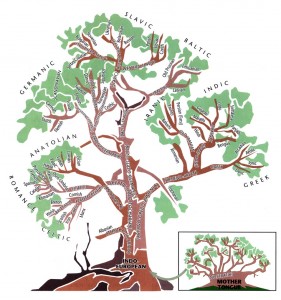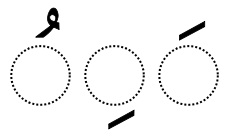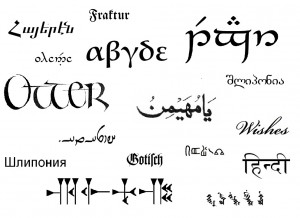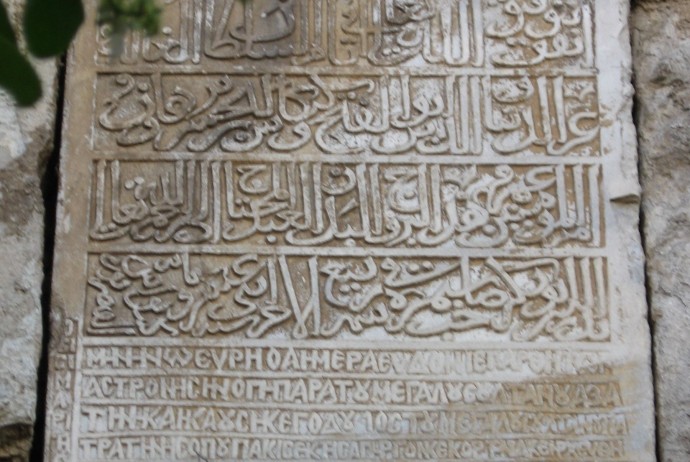Indo-European (IE) languages undoubtedly share many similarities with each other, as they all sprang from the same mother tongue, Proto-Indo-European (PIE). But it may strike you as odd that a language like Arabic, which is of a Semitic origin, actually shares some common features with PIE, given that they both are spoken in a different time and place — in no way could they could have borrowed from each other. Nevertheless, those who study both languages do perceive certain similarities, such as the phonological behavior of the laryngeals and the way that ablaut works.

The Laryngeals
One of the most striking similarities between PIE and Arabic is the presence of obstruents articulated behind the velum, sounds known in IE Studies as “laryngeals”. These segments, first reconstructed by the Swiss linguist Ferdinand De Saussure in 1879, are three in number: *h1, *h2, and *h3. But what did the PIE laryngeals sound like? While the exact phonetic quality of these sounds are debatable, varying from [Ɂ], [h], and [x] as in German to [Ɂ], [ʕ], and [ħ] as in modern Arabic, they were first named laryngeals by the Danish linguist Hermann Möller (1917), who believed that these segments were articulated in the larynx and were somehow connected to the Semitic gutturals.
As is conventionally done, we will use the symbols *h1, *h2, and *h3 to represent these sounds. Each behaves slightly differently within the PIE phonology. For instance, while *h1 does not affect the adjacent vowel *e (cf. *h1esti ‘is’), both *h2 and*h3 changed the pronunciation of an adjacent *e in PIE, through a process called laryngeal coloring. Thus, *e > *a next to *h2 (*/h2entí/ → *h2antí ‘front’ > Latin ante ‘before’, Hittite ḫanti ‘in the face’) and *e > *o next to *h3 (cf. */h3erbh-/ → *h3orbh– ‘to move from one social sphere to another’ > Greek orphanos ‘orphaned’).
- /biɁr/ → [bīr] ‘well’
- /raɁs/ → [rās] ‘head’
- /buɁra/ → [būra] ‘focus (n.)’
In Arabic the glottal stop [Ɂ] is written one of four ways, either joining one of the three weak consonants [a], [w], [y], or standing alone. Within the Arabic writing system, [Ɂ] is written like ٔا when above [a], ٔو when above [w], ٔي when above [y], and ء when alone.

When I note such similarities, I am not supposing that the PIE laryngeals were actually glottal stops, but I am also not supposing that they were not glottal segments, either — what matters is that each one of them was contrastive in PIE and were marked by distinct phonological features. So for the sake of argument if we say that *h1 has no coloring effect on the adjacent vowel *e then we may give it the symbol [h ̊], meaning that it has zero effect on the nearby vowel *e. For *h2 we may use the symbol [hi] in that it has a lowering effect on *e. And for *h3 we may use the symbol [hw], illustrating that this sound both rounded and backed an adjacent *e. So if PIE *h2 was like the sound [ħ] in Arabic then it was perhaps more like [ħi] or ح ,and if *h3 was like the sound [ʕ] then it should be more like [ʕw] or ع.
In the Arabic writing system the effect of vowel coloring works in the opposite fashion of PIE vowel coloring, which means that the kind of vowel that precedes the glottal determines its form. Arabic has three vowels: a, u, i. If a precedes [Ɂ] then the glottal stop will be written above the letter [a]. Notice that there is a difference between letter [a] which is written like ()ٔا) in Arabic, and the epenthetic vowel a, which is written like َ above the letter. If the vowel u precedes [Ɂ] then it will be written above the letter [w] (,ٔو) and if the vowel i precedes [Ɂ] then it will be written above the letter [y] (.ٔي). If no vowel precedes [Ɂ] or it is preceded by the anti-vowel symbol َthen it will be written alone without being attached to other letters as ء.

Ablaut
There is also some similarity between the verbal systems of PIE and Arabic. Both are inflected by the ablaut of the root, together with the addition of an optional suffix and required ending. Suffixes and endings indicate a variety of grammatical information, including voice (for instance, active vs. passive), mood (for instance, indicative vs. imperative), tense (for instance, present vs. past), person (for instance, the speaker vs. the listener), and number (for instance, singular vs. plural). In PIE there were two voices just as in Arabic, although the contrasting functions are slightly different (in PIE there is a distinction between active and mediopassive, while in Arabic it’s active vs. passive). PIE has in general three tense-aspect categories (present, past, and perfect), while Arabic has only two (present and aorist). In PIE the personal endings differ according to the voice whether it is active or middle and according to the tense so we have five sets of personal endings.

In Arabic, endings do not differ whether the verb is active or passive but it differs according to the tense whether it is past or present. Notice that Arabic has not only endings but also prefixes added to the beginnings of roots.
What we want to focus on here is the ablaut system of roots in both languages. In PIE there is a present stem, an aorist stem, and a perfect stem, and the present and aorist stems tend to have different ablaut formations according to whether the root is inflected as athematic or thematic. For instance, an athematic root like *h1es- ‘to be’ will show different ablaut patterns in the singular and plural formations: *h1es-ti ‘he is’ and *h1s-enti ‘they are’. Note that this ablaut is directly continued by German ist ~ sind and Latin est ~ sunt. Thematic roots in contrast show no differences between singular and plural: *bheresi ‘ you carry’ vs. *bherete ‘y’all carry’. But there are also other cases where the thematic roots are in zero-grade and stress on the suffix, such as *gʷem- ‘come’ → *gʷm̥-ské-ti ‘goes, comes’ (Sanskrit gacchati).
In Arabic, the ablaut verb system will differ depending on whether the verb is a three-letter (triliteral) base or a four-letter (quadriliteral) base (of course, all letters in Arabic are considered consonants). In the three-letter base of the aorist tense, the ablaut occurs only on the second vowel (the vowel before the last consonant). While the first vowel (the vowel after the first consonant) is always a, the second vowel may be either a, i, or u. Compare:
- katab – a ‘writes’ from the root k-t-b
- ħasib – a ‘counts’ from the root ħ-s-b
- ħasun – a ‘makes it look better’ from the root ħ-s-n
In verbs with a four-letter base the ablaut of the aorist occur on the last vowel also (before the forth consonant) and is always a. Compare:
- daħraj – a ‘ rolls along’ from the root d-ħ-r-j
In the present tense for the three letter bases, ablaut is quite different. There is a deletion of the first vowel (just as zero-grade in PIE), and a symbol may be added above the first letter to represent what is called the “anti-vowel”: < َ >.  The second vowel will undergo a change into a, i, or u. Sometimes it stays the same in both the present and aorist, but besides that we shouldn’t forget the addition of the ending and prefix to indicate the present tense. Sadly for learners of Arabic, how to know which vowel to use is a simple matter of memorization. For example:
The second vowel will undergo a change into a, i, or u. Sometimes it stays the same in both the present and aorist, but besides that we shouldn’t forget the addition of the ending and prefix to indicate the present tense. Sadly for learners of Arabic, how to know which vowel to use is a simple matter of memorization. For example:
- ya – mnaɁ – u ‘prevents’ from the root m-n-Ɂ
- ya – ħsib – u ‘counts’ from the root ħ-s-b
- ya – ħsun – u ‘makes it look better’ from the root ħ-s-n
Four – letter root always substitute the last vowel a in the aorist stem with i in the present, though nothing else changes. For example:
- yu-daħrij-u ‘rolls along’ from the root d-ħ-r-j

Once again by citing these similarities I am not assuming that PIE and Arabic in any way are part of the same language family. It is of course true that there are some similarities but the differences are much greater. But these two languages very well may be related — at some remote point in time. Just as all human beings ultimately spring from the very first cell that developed to be the first creature, it is reasonable to say that all human languages could have sprung from the same, very old language. But of course it is now impossible to reconstruct all of the details of this first, hypothetical language, just as it is impossible to reconstruct the first human.

Written by Anfal M. Ali
For Further Reading:
- Biography of Ferdinand De Saussure: http://floridalinguistics.com/?page_id=507ChromeHTML\Shell\Open\CommanChromeHTML\Shell\Open\Command
- Byrd, Andrew Miles. “The Phonology of Proto-Indo-European“. In Jared S. Klein, Brian Joseph, and Matthias Fritz (eds.), Comparative Indo-European Linguistics. An International Handbook of Language Comparison and the Reconstruction of Indo-European. Berlin: Mouton de Gruyter.
- Arabic Online: http://arabic.tripod.com/Arab20.htm#Vowels
- Forston, Benjamin, 2010. Indo-European Language and Culture, second edition. Wiley-Blackwell. p.91.
- Meier-Brügger, Michael, 2003. Indo-European Linguistics. De Gruyter. pp.168-171.
